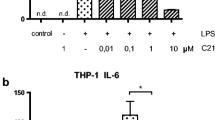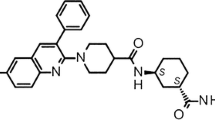Abstract
The antiinflammatory activity of rolipram, a selective inhibitor of the cyclic AMP-specific phosphodiesterase (PDE IV), was studied. Rolipram did not inhibit 5-lipoxygenase activity but did inhibit human monocyte production of leukotriene B4 (LTB4, IC50 3.5 μM). Likewise, murine mast cell release of leukotriene C4 and histamine was inhibited. In vivo, rolipram inhibited arachidonic acid-induced inflammation in the mouse, while the lowK m-cyclic-GMP PDE inhibitor, zaprinast, did not inhibit. Rolipram had a modest effect on LTB4 production in the mouse, but markedly reduced LTB4-induced PMN infiltration. Beta-adrenergic receptor activation of adenylate cyclase was important for rolipram antiinflammatory activity since beta blockade abrogated arachidonic acid-induced inflammation. Thus, the antiinflammatory profile of rolipram is novel and may result from inhibition of PMN function and perhaps vasoactive amine release and leukotriene biosynthesis. These actions may be dependent upon endogenous beta-adrenergic activity and are likely mediated through inhibition of PDE IV.
Similar content being viewed by others
References
Schwabe, U., M. Miyake, Y. Ohga, andJ. W. Daly. 1976. 4-(3-Cyclopentyloxy-4-meth-oxyphenyl)-2-pyrrolidone (ZK 62711): A potent inhibitor of adenosine cyclic 3',5'-monophosphate phosphodiesterase in homogenates and tissue slices from rat brain.Mol. Pharmacol. 12:900–910.
Reeves, M. L., B. K. Leigh, andP. J. England. 1987. The identification of a new cyclic nucleotide phosphodiesterase activity in human and guinea-pig cardiac ventrical.Biochem. J. 241:535–541.
Torphy, T. J., G. P. Livi, J. M. Balcarek, J. R. White, F. H. Chilton, andUndem, B. J. 1992. Therapeutic potential of isozyme-selective phosphodiesterase inhibitors in the treatment of asthma.Adv. Second Messenger Phosphoprotein Res. 25:289–305.
Wachtel, H., P. A. Loschmann, H. H. Schneider, andK. J. Rettig. 1987. Effects of forskolin on spontaneous behavior, rectal temperature and brain cAMP levels of rats: Interaction with rolipram.Neurosci. Lett. 76:191–196.
Donaldson, J., A. M. Brown, andS. J. Hill. 1988. Influence of rolipram on the cyclic 3'-5'-adenosine monophosphate response to histamine and adenosine in slices of guinea-pig cerebral cortex.Biochem. Pharmacol. 37:715–723.
Marivet, M. C., J. J. Bourguignon, C. Lugnier, A. Mann, J. C. Stoclet, andC. G. Wermuth. 1989. Inhibition of cyclic adenosine-3'-5'-monophosphate phosphodiesterase from vascular smooth muscle oy rolipram analogues.J. Med. Chem. 32:1450–1457.
Sullivan, T. J., K. L. Parker, A. Kulczycki, andC. W. Parker. 1976. Modulation of cyclic AMP in purified rat mast cells. III. Studies on the effect of concanavalin A and anti-IgE on cAMP concentrations during histamine release.J. Immunol. 117:713–716.
Ennis, M., A. Truneh, J. R. White, andF. L. Pearce. 1981. Inhibition of histamine release from mast cells.Nature 289:186–187.
Glaser, T., andJ. Traber. 1984. TVX 2706-a new phosphodiesterase inhibitor with antiinflammatory action biochemical characterization.Agents Actions 15:341–348.
Griswold, D. E., E. Webb, L. Schwartz, andN. Hanna. 1987. Arachidonic acid-induced inflammation: Inhibition by dual inhibitor of arachidonic acid metabolism, SK&F 86002.Inflammation 11:189–199.
Griswold, D. E., S. Hoffstein, P. J. Marshall, E. F. Webb, L. Hillegass, P. E. Bender, andN. Hanna. 1989. Inhibition of inflammatory cell infiltration by bicyclic imidazoles, SK&F 86002 and SK&F 104493.Inflammation 13:727–739.
Shore, P. A., A. Burkhalter, andV. H. Cohn. 1959. A method for the fluorometric assay of histamine in tissues.J. Pharmacol. Exp. Ther. 127:182–186.
Griswold, D. E., E. F. Webb, andL. M. Hillegass. 1991. Induction of plasma exudation and inflammatory cell infiltration by leukotriene C4 and leukotriene B4 in mouse peritonitis.Inflammation 15:251–258.
Bradley, P. P., D. A. Priebat, R. D. Christensen, andG. Rothstein. 1982. Measurement of cutaneous inflammation: Estimation of neutrophil content with an enzyme marker.J. Invest. Dermatol. 78:206–209.
Colatta, F., G. Peri, A. Villa, andA. Mantovani. 1984. Rapid killing of actinomycin D-treated tumor cells by human mononuclear cells. 1. Effectors belong to the monocyte-macrophage lineage.J. Immunol. 132:936–944.
Young, J. M., D. A. Spires, C. J. Bedford, B. Wagner, S. J. Ballaron, andL. M. Deyoung. 1984. The mouse ear inflammatory response to topical arachidonic acid.J. Invest. Dermatol. 82:367–371.
Carlson, R. P., L. O'Neill-Davis, J. Chang, andA. J. Lewis. 1986. Modulation of mouse ear edema by cyclooxygenase and lipoxygenase inhibitors and other pharmacologic agents.Agents Actions 17:197–204.
Crummey, A., G. P. Harper, E. A. Boyle, andF. R. Mangan. 1987. Inhibition of arachidonic acid-induced ear oedema as a model for assessing topical anti-inflammatory compounds.Agents Actions 20:69–76.
Bergstrand, H., J. Kristoffersson, B. Lundquist, andA. Schurmann. 1977. Effects of antiallergic agents, compound 48/80, and some reference inhibitors on the activity of partially purified human lung tissue adenosine cyclic 3',5'-monophosphate and guanosine cyclic 3',5'-monophosphate phosphodiesterases.Mol. Pharmacol. 13:38–43.
Harris, A. L., B. M. Lemp, R. G. Bentley, M. H. Perrone, L. T. Hamel, andP. J. Silver. 1989. Phosphodiesterase isozyme inhibition and the potentiation by zaprinast of endothelium-derived relaxing factor and guanylate cyclase stimulating agents in vascular smooth muscle.J. Pharmacol. Exp. Ther. 249:394–400.
Undem, B. J., T. J. Torphy, D. Goldman, andF. H. Chilton. 1990. Inhibition by adenosine 3',5'-monophosphate of eicosanoid and platelet-activating factor biosynthesis in the mouse PT-18 mast cell.J. Biol. Chem. 265:6750–6758.
Undem, B. J., andC. K. Buckner. 1986. Mechanisms of β-adrenergic agonist-induced inhibition of immunologie mediator release.In Current Topics in Pulmonary and Toxicology. M. A. Hollinger, editors. Elsevier Science Press, New York. 57–88.
Underwood, D. C, J. K. Matthews, R. R. Osborn, L. B. Novak, andT. J. Torphy. 1992. The significance of β-adrenergic activity on the inhibitory effects of rolipram against early and late phase response to antigen in the guinea pig. American Thoracic Society Annual Meeting Abstracts.
Author information
Authors and Affiliations
Rights and permissions
About this article
Cite this article
Griswold, D.E., Webb, E.F., Breton, J. et al. Effect of selective phosphodiesterase type IV inhibitor, rolipram, on fluid and cellular phases of inflammatory response. Inflammation 17, 333–344 (1993). https://doi.org/10.1007/BF00918994
Issue Date:
DOI: https://doi.org/10.1007/BF00918994




